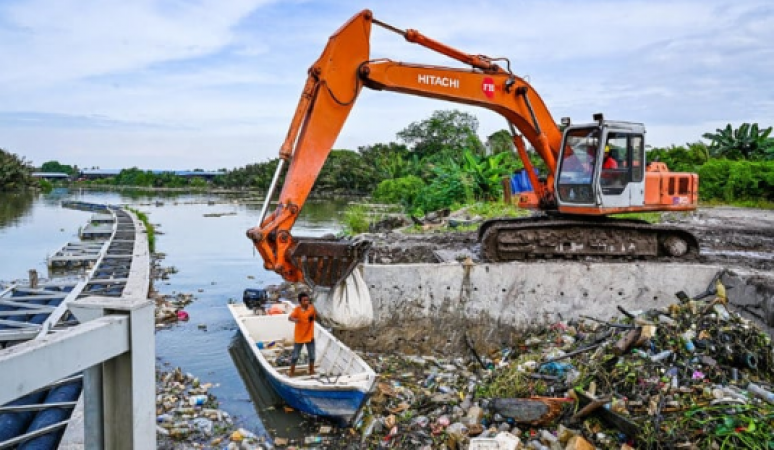
Kuala Lumpur: Semporna, a remote town at the northernmost tip of Borneo, is famous for having some of the most beautiful diving sites and marine life in Malaysia, but in recent years, that fame has been waning as plastic waste litters the shoreline.
One of the most pressing environmental issues is plastic pollution. Over the past 20 years, the production of disposable plastic items has grown exponentially, outstripping the global capacity to handle them.
Global plastic production exceeds 380 million tonnes annually, of which about half is single-use plastic, or plastic that is discarded after use, such as bags or food packaging. According to Plastic Oceans, 10 million tons of plastic enter the ocean each year, of which less than 10% is recycled.
Also Read: US Justice Department discovered additional classified documents while searching the Biden residence
Residents of Semporna and other areas in the picturesque state of Sabah have seen their beaches and coral reefs slowly disappear while being poisoned and disfigured as a result of eating indigestible litter.
Students from Mara Junior Science College in Semporna have developed a solution to the pollution issue after realizing the conveniences provided by plastics and the impossibility of eliminating them from our lives: they decided to combat plastic with plastic, Although it is made in a different way. Seaweed that doesn't harm marine life.
Their biology teacher and project mentor Shahrul Hafiz Abdul Ghani told Arab News that because the students are natives of Semporna, they feel a responsibility to preserve and protect the region's stunning islands and marine life.
In Semporna, seaweed is an abundant natural resource, so they chose to use it to make seaweed-based bioplastics such as straws and plastic bags. Because it degrades naturally, it will reduce our reliance on plastics.
Also Read: Burkina Faso dissolves relations with French forces and orders their departure
Kappaphycus is a genus of red algae that is prevalent in Malaysian waters, and is being used by Ghani's team, which also includes Faheem Nazan, Muhammad Fauzan Lakrani and Muhammad Fauzi Lakrani.
Seaweed, one of the fastest growing organisms on the planet, could replace plastic in packaging as well as being more environmentally friendly. It takes four to six weeks to biodegrade.
We are currently working on improving the prototype to ensure that it has ideal durability and plasticity. Seaweed has commercial potential, and we are looking for additional funding for our bioplastic, said Gani, who also noted that his students will present their prototype seaweed plastic bags, utensils and straws this year.
Due to recent advances in processing technology, currently the only significant limitation is the cost of producing seaweed-based bioplastics.
According to Chung Ngin Jhun, who founded Malaysian seaweed startup Rodomax four years ago, there is still insufficient support for these initiatives to succeed.
What many Malaysians don't know is that seaweed can be used for things other than making sushi nori. Since 2018, the government has taken steps to eliminate single-use plastic.
Progress is being made in that direction, but such trends are generally set by the wealthier members of society. He claimed that this is not really a holistic strategy, perhaps as a result of a lack of education.
In Malaysia, Chung's business is a leader in the production of mineral supplements, bioplastics and vegan leather made from seaweed. Being a native of Sabah, he obtains raw material from the neighboring countries of Sabah and Indonesia.
According to Chung, the industry will find it challenging to develop locally, despite the abundance of seaweed. "It grows naturally without the use of land, without the use of agricultural inputs, and even without the use of fresh water," she said.
“Unfortunately, there is a lack of narrative in this side of the world; the global south only produces raw materials,” lacks the infrastructure needed to support initiatives like ours, as well as information to law- and law-makers how to implement policies that support projects like ours.
According to Siti Nahdatul Isnaini Said Hussein, a scientist at the National Institute of Biotechnology Malaysia, the continuity of supply may also be a hindrance to the development of the seaweed industry in Malaysia.
Plant diseases have disrupted the cultivation cycle, he said, adding that "the current rate of production in Sabah coastal areas is not promising enough to ensure a sustainable source of seaweed supply for commercial bioplastic production."
On the other hand, regular overseas buyers of the area's seaweed, mainly from China, offer producers higher prices than in the local market.
Hussain believes that seaweed bioplastic development in Malaysia could be more successful if it were linked to other properties of the material, particularly its palatability and appeal to consumers in the Muslim-majority nation as a halal product.
"By focusing on the strength of the seaweed itself — its high nutritional content, edible and water-soluble anti-inflammatory properties," she said, "the future of seaweed-based bioplastics could be more promising."
Also Read: Machu Picchu is shut down by Peru as anti-government protests intensify
The use of bioplastics for halal encapsulation, edible food sachets, and other food-related applications would be more appealing and commercially viable.